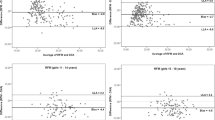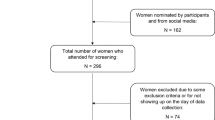Abstract
Objective
To verify the validity of anthropometric methods body adiposity index (BAI), relative fat mass (RFM) and body fat index (BFI) to estimate body fat percentage (%BF) in adolescents.
Methods
A cross-sectional study was carried out with 420 Brazilian adolescents aged 15–19 years, stratified by age (< 18 years, n = 356; ≥ 18 years, n = 64) and sex (boys, n = 216; girls, n = 204). The Anthropometric measurements height, body weight, hip circumference and waist circumference were collected to calculate the %BF by BAI, RFM, BFI methods. Subsequently, %BF was measured by dual emission X-ray absorptiometry (DXA), adopted as a reference method. In the statistical analysis of the data, the Pearson correlation test and the paired t test between %BF obtained by the equations and by the DXA were performed. The method validation criterion was that 68% of individuals should be within an acceptable error range of ± 3.5% of BF and Cohen's Kappa index ≥ 0.61. Additionally, the Bland–Altman graphical analysis was performed.
Results
All methods showed a high correlation with DXA. For the Kappa index, only the RFM reached the criterion in the total sample (0.67) and in the sample < 18 years (0.68). None of the methods reached the criterion of 68% of the sample within the error range of ± 3.5% of BF.
Conclusion
The BAI, RFM and BFI equations were not valid for predicting BF in the studied sample according to the criteria adopted regardless of sex or age.
Level of evidence
Level V, cross-sectional descriptive study.





Similar content being viewed by others
Data availability
All relevant data are within the manuscript.
References
World Health Organization (2017) Facts and figures on childhood obesity. Last accessed date May 13th, 2021. Available at: http://www.who.int/end-childhood-obesity/facts/en/
Berg AH, Scherer PE (2005) Adipose tissue, inflammation, and cardiovascular disease. Circ Res 96:939–949. https://doi.org/10.1161/01.RES.0000163635.62927.34
Hjartåker A, Langseth H, Weiderpass E (2008) Obesity and diabetes epidemics. Innov. Endocrinol. Cancer, Springer 72–93. https://doi.org/10.1007/978-0-387-78818-0_6
Lauby-Secretan B, Scoccianti C, Loomis D et al (2016) Body Fatness and Cancer-Viewpoint of the IARC Working Group. N Engl J Med 375:794–798. https://doi.org/10.1056/NEJMsr1606602
Zheng Y, Manson JE, Yuan C et al (2017) Associations of weight gain from early to middle adulthood with major health outcomes later in life. JAMA 318:255–269. https://doi.org/10.1001/jama.2017.7092
Reilly JJ, Kelly J (2011) Long-term impact of overweight and obesity in childhood and adolescence on morbidity and premature mortality in adulthood: systematic review. Int J Obes 35:891–898. https://doi.org/10.1038/ijo.2010.222
Tomiyama AJ, Hunger JM, Nguyen-Cuu J, Wells C (2016) Misclassification of cardiometabolic health when using body mass index categories in NHANES 2005–2012. Int J Obes 40:883–886. https://doi.org/10.1038/ijo.2016.17
Martin AD, Drinkwater DT (1991) Variability in the measures of body fat. Assumptions or technique? Sports Med Auckl NZ 11:277–288. https://doi.org/10.2165/00007256-199111050-00001
Bergman RN, Stefanovski D, Buchanan TA et al (2011) A better index of body adiposity. Obes Silver Spring Md 19:1083–1089. https://doi.org/10.1038/oby.2011.38
Woolcott OO, Bergman RN (2018) Relative fat mass (RFM) as a new estimator of whole-body fat percentage ─ a cross-sectional study in American adult individuals. Sci Rep 8:10980. https://doi.org/10.1038/s41598-018-29362-1
Yang HI, Cho W, Ahn KY et al (2020) A new anthropometric index to predict percent body fat in young adults. Public Health Nutr 23:1507–1514. https://doi.org/10.1017/S1368980019004191
Vlassopoulos A, Combet E (2005) Lean MEJ (2014) Changing distributions of body size and adiposity with age. Int J Obes 38:857–864. https://doi.org/10.1038/ijo.2013.216
Cerqueira MS, Santos CAD, Silva DAS et al (2018) Validity of the Body Adiposity Index in Predicting Body Fat in Adults: a systematic review. Adv Nutr Bethesda Md 9:617–624. https://doi.org/10.1093/advances/nmy043
Wickel EE (2014) Evaluating the utility of the body adiposity index in adolescent boys and girls. J Sci Med Sport 17:434–438. https://doi.org/10.1016/j.jsams.2013.06.002
De Santis FM, Cecon RS, de Faria ER et al (2019) Agreement of body adiposity index (BAI) and paediatric body adiposity index (BAIp) in determining body fat in Brazilian children and adolescents. Public Health Nutr 22:132–139. https://doi.org/10.1017/S1368980018002458
de Macêdo CT, de Almeida-Neto PF, de Matos DG et al (2021) Evaluation of the body adiposity index against dual-energy X-ray absorptiometry for assessing body composition in children and adolescents. Am J Hum Biol Off J Hum Biol Counc 33:e23503. https://doi.org/10.1002/ajhb.23503
Woolcott OO, Bergman RN (2019) Relative Fat Mass as an estimator of whole-body fat percentage among children and adolescents: a cross-sectional study using NHANES. Sci Rep 9:15279. https://doi.org/10.1038/s41598-019-51701-z
de Onis M, Onyango AW, Borghi E et al (2007) Development of a WHO growth reference for school-aged children and adolescents. Bull World Health Organ 85:660–667. https://doi.org/10.2471/blt.07.043497
Verhaegen AA, Van Gaal LF (2021) Drugs Affecting Body Weight, Body Fat Distribution, and Metabolic Function-Mechanisms and Possible Therapeutic or Preventive Measures: an Update. Curr Obes Rep 10:1–13. https://doi.org/10.1007/s13679-020-00419-5
Marfell-Jones MJ, Stewart AD, De Ridder JH (2012) International standards for anthropometric assessment. http://hdl.handle.net/11072/1510
Bazzocchi A, Ponti F, Albisinni U et al (2016) DXA: technical aspects and application. Eur J Radiol 85:1481–1492. https://doi.org/10.1016/j.ejrad.2016.04.004
George D, Mallery P (2019) IBM SPSS statistics 26 step by step: A simple guide and reference. Routledge
Watson PF, Petrie A (2010) Method agreement analysis: a review of correct methodology. Theriogenology 73:1167–1179. https://doi.org/10.1016/j.theriogenology.2010.01.003
Cohen J (1960) A Coefficient of Agreement for Nominal Scales. Educ Psychol Measur 20:37–46. https://doi.org/10.1177/001316446002000104
Lohman TG (1987) The use of skinfold to estimate body fatness on children and youth. J Phys Educ Recreat Dance 58:98–103. https://doi.org/10.1080/07303084.1987.10604383
Bottaro MF, Heyward VH, Bezerra RF, Wagner DR (2002) Skinfold method vs dual-energy x-ray absorptiometry to assess body composition in normal and obese women. J Exerc Physiol Online 5:11–18
Doran DA, Mc Geever S, Collins KD et al (2014) The validity of commonly used adipose tissue body composition equations relative to dual energy X-ray absorptiometry (DXA) in gaelic games players. Int J Sports Med 35:95–100. https://doi.org/10.1055/s-0033-1333693
Krouwer JS (2008) Why Bland-Altman plots should use X, not (Y+X)/2 when X is a reference method. Stat Med 27:778–780. https://doi.org/10.1002/sim.3086
Ripka WL, Orsso CE, Haqq AM et al (2020) Validity and accuracy of body fat prediction equations using anthropometrics measurements in adolescents. Eat Weight Disord EWD 26:879–886. https://doi.org/10.1007/s40519-020-00918-3
Flegal KM, Graubard B (2005) Ioannidis JPA (2020) Use and reporting of Bland-Altman analyses in studies of self-reported versus measured weight and height. Int J Obes 44:1311–1318. https://doi.org/10.1038/s41366-019-0499-5
Bland JM, Altman DG (1986) Statistical methods for assessing agreement between two methods of clinical measurement. Lancet Lond Engl 1:307–310. https://doi.org/10.1016/S0140-6736(86)90837-8
Johnson W, Chumlea WC, Czerwinski SA, Demerath EW (2012) Concordance of the recently published body adiposity index with measured body fat percent in European-American adults. Obes Silver Spring Md 20:900–903. https://doi.org/10.1038/oby.2011.346
Segheto W, Coelho FA, Guimarães C, da Silva D et al (2017) Validity of body adiposity index in predicting body fat in Brazilians adults. Am J Hum Biol Off J Hum Biol Counc. https://doi.org/10.1002/ajhb.22901
Jager J, Putnick DL, Bornstein MH (2017) II. More than just convenient: the scientific merits of homogeneous convenience samples. Monogr Soc Res Child Dev 82:13–30. https://doi.org/10.1111/mono.12296
Silva AM, Fields DA, Sardinha LB (2013) A PRISMA-driven systematic review of predictive equations for assessing fat and fat-free mass in healthy children and adolescents using multicomponent molecular models as the reference method. J Obes 2013:148696. https://doi.org/10.1155/2013/148696
Messina C, Albano D, Gitto S, et al (2020) Body composition with dual energy X-ray absorptiometry: from basics to new tools. Quant Imaging Med Surg 10:1687–1698. https://doi.org/10.21037/qims.2020.03.02
Acknowledgements
The equipment for data collection in the present study was provided by the Human Performance Laboratory of the Department of Physical Education, Federal University of Viçosa, headed by Professor João Carlos Bouzas Marins.
Funding
No funds, grants, or other support was received.
Author information
Authors and Affiliations
Contributions
IGAE and MSC contributed to all parts of this study. JCBM, PM and DS are responsible for data interpretation and manuscript revision. All authors approved the final manuscript.
Corresponding author
Ethics declarations
Conflict of interest
The authors declare that there is no conflict of interest.
Ethical approval
The study protocol has been approved by the ethics committee of the Universidade Federal de Viçosa (Plataforma Brasil system, nº CAAE 99311418.0.0000.5153).
Informed consent
All of the participants signed and approved a written informed consent before participation in the study.
Additional information
Publisher's Note
Springer Nature remains neutral with regard to jurisdictional claims in published maps and institutional affiliations.
Rights and permissions
About this article
Cite this article
Encarnação, I.G.A., Cerqueira, M.S., Silva, D.A.S. et al. Prediction of body fat in adolescents: validity of the methods relative fat mass, body adiposity index and body fat index. Eat Weight Disord 27, 1651–1659 (2022). https://doi.org/10.1007/s40519-021-01301-6
Received:
Accepted:
Published:
Issue Date:
DOI: https://doi.org/10.1007/s40519-021-01301-6




